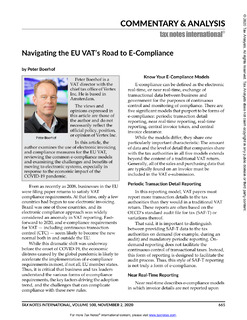In this Tax Notes International article, Vertex VAT Director Peter Boerhof examines the use of electronic invoicing and compliance measures for the EU VAT, reviewing the common e-compliance models and examining the challenges and benefits of moving to electronic systems, especially in response to the economic impact of the COVID-19 pandemic.
Even as recently as 2008, businesses in the EU were filing paper returns to satisfy VAT compliance requirements. At that time, only a few countries had begun to use electronic invoicing. Fast forward to 2020, and e-compliance requirements for VAT — including continuous transaction control (CTC) — seem likely to become the new normal both in and outside the EU.
While this dramatic shift was underway before the onset of COVID-19, the economic distress caused by the global pandemic is likely to accelerate the implementation of e-compliance requirements in most, if not all, EU member states. Thus, it is critical that business and tax leaders understand the various forms of e-compliance requirements, the key factors driving the adoption trend, and the challenges that can complicate compliance with these new rules.
In this article, Peter addresses the following questions and more:
- What are the e-compliance models?
- What are the pros and cons of pre-filled reports?
- How is e-compliance developing?
- What are the key compliance challenges?


